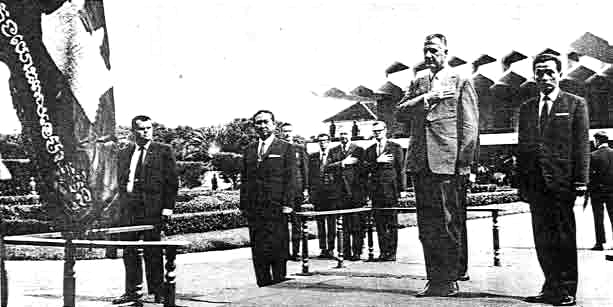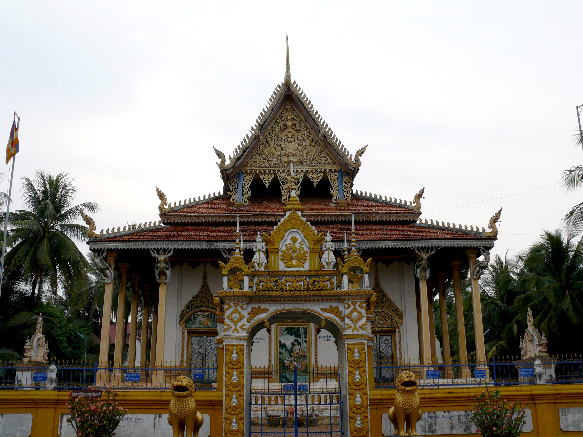|
Cambodian People's Armed Forces
The Kampuchean People's Revolutionary Armed Forces (KPRAF), also the Khmer People's Revolutionary Armed Forces were the armed forces of the People's Republic of Kampuchea, the ''de facto'' government of Cambodia 1979–1990. It was formed with military assistance from Vietnam, which furbished the fledgling armed forces with equipment and training, with the initial task of countering the sustained guerrilla campaign being waged by the Coalition Government of Democratic Kampuchea. The KPRAF were renamed the Cambodian People's Armed Forces (CPAF) in 1989, preserving their main structure, but changing insignias and symbols. In 1993 the CPAF were absorbed into the newly re-established Royal Cambodian Armed Forces. Historical background The KPRAF was formed initially from militias, former Khmer Rouge members, and conscripts. Most of them were trained and supplied by the Vietnam People's Army. But due to a lack of training, weapons and mass desertions, the KPRAF was not an effective f ... [...More Info...] [...Related Items...] OR: [Wikipedia] [Google] [Baidu] |
Flag Of The People's Republic Of Kampuchea
The flag of the People's Republic of Kampuchea was a historical flag of Cambodia from 1979 to 1989, used during the Cambodian–Vietnamese War. The flag that became the official flag of the People's Republic of Kampuchea had been previously adopted by the Kampuchean United Front for National Salvation (KUFNS), who had revived the flag of the Khmer Issarak in the days of anti-French resistance, declaring it the flag of the PRK. State of Cambodia In 1989, Hun Sen renamed the country as the State of Cambodia and changed the flag: instead of just fully red, it was half red above and half blue below, reviving the blue color of preceding Cambodian flags. It had a yellow five-towered Angkor Wat silhouette in the center like the first. In some versions the Angkor Wat of the State of Cambodia flag displayed the architectural details of the Angkorian structure outlined in black. Although the flags of the People's Republic of Kampuchea, and later the flag of the State of Cambodia, beca ... [...More Info...] [...Related Items...] OR: [Wikipedia] [Google] [Baidu] |
Soviet Union
The Soviet Union,. officially the Union of Soviet Socialist Republics. (USSR),. was a List of former transcontinental countries#Since 1700, transcontinental country that spanned much of Eurasia from 1922 to 1991. A flagship communist state, it was nominally a Federation, federal union of Republics of the Soviet Union, fifteen national republics; in practice, both Government of the Soviet Union, its government and Economy of the Soviet Union, its economy were highly Soviet-type economic planning, centralized until its final years. It was a one-party state governed by the Communist Party of the Soviet Union, with the city of Moscow serving as its capital as well as that of its largest and most populous republic: the Russian Soviet Federative Socialist Republic, Russian SFSR. Other major cities included Saint Petersburg, Leningrad (Russian SFSR), Kyiv, Kiev (Ukrainian Soviet Socialist Republic, Ukrainian SSR), Minsk (Byelorussian Soviet Socialist Republic, Byelorussian SSR), Tas ... [...More Info...] [...Related Items...] OR: [Wikipedia] [Google] [Baidu] |
BM-21 Grad
The BM-21 "Grad" (russian: БМ-21 "Град", lit= hail) is a self-propelled 122 mm multiple rocket launcher designed in the Soviet Union. The system and the M-21OF rocket were first developed in the early 1960s, and saw their first combat use in March 1969 during the Sino-Soviet border conflict. ''BM'' stands for ''boyevaya mashina'' ( ru , боевая машина – combat vehicle), and the nickname means "hail". The complete system with the BM-21 launch vehicle and the M-21OF rocket is designated as the M-21 field-rocket system. The complete system is more commonly known as a Grad multiple rocket launcher system. In NATO countries the system, either the complete system or the launch vehicle only, was initially known as the M1964. Several other countries have copied the Grad or have developed similar systems. In Russian service its intended replacement is the 9A52-4 Tornado. Many similar 122 mm MLRS systems are made by different countries based on the BM-21 Grad. ... [...More Info...] [...Related Items...] OR: [Wikipedia] [Google] [Baidu] |
Khmer Republic
The Khmer Republic ( km, សាធារណរដ្ឋខ្មែរ, ; french: République khmère) was a pro-United States military-led republican government of Cambodia that was formally declared on 9 October 1970. The Khmer Republic was politically headed by Prime Minister Lon Nol and Prince Sisowath Sirik Matak who took power in the 18 March 1970 coup against Prince Norodom Sihanouk. The main causes of the coup were Norodom Sihanouk's toleration of the North Vietnamese activity within Cambodia's borders, allowing heavily armed Vietnamese communist outfits ''de facto'' control over vast areas of eastern Cambodia. Another important factor was the dire state of the Cambodian economy, an indirect result of Sihanouk's policies of pursuing neutrality. With the removal of Sihanouk, the existing Kingdom of Cambodia became a republic, officially removing Sisowath Kossamak. The character of the new regime was far-right and militaristic; most significantly, it ended Sihano ... [...More Info...] [...Related Items...] OR: [Wikipedia] [Google] [Baidu] |
Tonlé Sap
Tonlé Sap (; km, ទន្លេសាប, ; or commonly translated as 'Great Lake'; vi, Biển Hồ, Chữ Hán: 湖海/壺海) is a lake in the northwest of Cambodia. It belongs to the Mekong River system. It is the largest freshwater lake in Southeast Asia and one of the most diverse and productive ecosystems in the world, designated as a Biosphere Reserve by UNESCO in 1997 due to its high biodiversity. Entering the 21st century, the lake and its surrounding ecosystems are under increasing pressure from deforestation, infrastructure development and climate change. Geography Tonlé Sap Lake is located in the northwest of the lower Mekong plain, formed by the collision and collapse of the Indian Plate and the Eurasian Plate. The lower Mekong plain used to be a bay, and the sea level rose rapidly at the end of the last glacial period. About high, cores from this period found near Angkor contain tidal deposits, as well as salt marshes and mangrove swamp deposits, deposite ... [...More Info...] [...Related Items...] OR: [Wikipedia] [Google] [Baidu] |
Siem Reap
Siem Reap ( km, សៀមរាប, ) is the second-largest city of Cambodia, as well as the capital and largest city of Siem Reap Province in northwestern Cambodia. Siem Reap has French colonial and Chinese-style architecture in the Old French Quarter and around the Old Market. In the city, there are museums, traditional Apsara dance performances, a Cambodian cultural village, souvenir and handicraft shops, silk farms, rice paddies in the countryside, fishing villages and a bird sanctuary near Tonlé Sap, and a cosmopolitan drinking and dining scene. Cambodia’s Siem Reap city, home to the famous Angkor Wat temples, was crowned the ASEAN City of Culture for the period 2021–2022 at the 9th Meeting of the ASEAN Ministers Responsible for Culture and Arts (AMCA) organised on Oct 22, 2020. Siem Reap today—being a popular tourist destination—has many hotels, resorts, and restaurants. This owes much to its proximity to the Angkor Wat temples, Cambodia's most popular tou ... [...More Info...] [...Related Items...] OR: [Wikipedia] [Google] [Baidu] |
Battambang
Battambang ( km, បាត់ដំបង, Romanization of Khmer#UNGEGN, UNGEGN: ) is the capital of Battambang Province and the third largest city in Cambodia. Founded in the 11th century by the Khmer Empire, Battambang is the leading rice-producing province of the country. For nearly 100 years it was a major commercial hub and provincial capital of Siamese province of Inner Cambodia (1795-1907), though it was always populated by Khmer, with some ethnic Vietnamese, Lao, Thai and Chinese. Battambang remains the hub of Cambodia's northwest, connecting the region with Phnom Penh and Thailand. The city is situated on the Sangkae River, a tranquil, small body of water that winds its way picturesquely through Battambang Province. As with much of Cambodia, French Colonial architecture is a notable aspect of the city, with some of the best-preserved examples in the country. Now the government and Ministry of Culture and Fine Art are preparing documents to nominate The Old Town of Batt ... [...More Info...] [...Related Items...] OR: [Wikipedia] [Google] [Baidu] |
Cambodian People's Party
The Cambodian People's Party (CPP), UNGEGN: , ALA-LC: ; is a Cambodian political party which has ruled Cambodia since 1979. Founded in 1951, it was originally known as the Kampuchean People's Revolutionary Party (KPRP)., UNGEGN: , ALA-LC: ; Adopting a more revisionist view of Marxism, it allied itself with Vietnam and the Soviet Union, in contrast to the Communist Party of Kampuchea led by Pol Pot, which was pro-Chinese. After toppling the Khmer Rouge regime with the Vietnamese-backed liberation of Phnom Penh, it became the ruling party of the People's Republic of Kampuchea (1979–1989), which was later renamed the State of Cambodia (1989–1991). The party's current name was adopted during the final year of the State of Cambodia, when the party abandoned the one-party system and Marxism–Leninism. Originally rooted in communist and Marxist–Leninist ideologies, the party took on a more reformist outlook in the mid-1980s under Heng Samrin. In 1991, the CPP officially d ... [...More Info...] [...Related Items...] OR: [Wikipedia] [Google] [Baidu] |
Soviet F1 Hand Grenades
The Soviet Union,. officially the Union of Soviet Socialist Republics. (USSR),. was a transcontinental country that spanned much of Eurasia from 1922 to 1991. A flagship communist state, it was nominally a federal union of fifteen national republics; in practice, both its government and its economy were highly centralized until its final years. It was a one-party state governed by the Communist Party of the Soviet Union, with the city of Moscow serving as its capital as well as that of its largest and most populous republic: the Russian SFSR. Other major cities included Leningrad (Russian SFSR), Kiev (Ukrainian SSR), Minsk (Byelorussian SSR), Tashkent (Uzbek SSR), Alma-Ata (Kazakh SSR), and Novosibirsk (Russian SFSR). It was the largest country in the world, covering over and spanning eleven time zones. The country's roots lay in the October Revolution of 1917, when the Bolsheviks, under the leadership of Vladimir Lenin, overthrew the Russian Provisional Government t ... [...More Info...] [...Related Items...] OR: [Wikipedia] [Google] [Baidu] |


